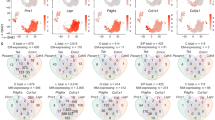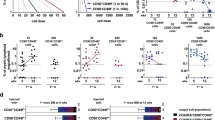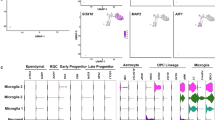Abstract
The concept that bone marrow (BM)-derived cells participate in neural regeneration remains highly controversial and the identity of the specific cell type(s) involved remains unknown. We recently reported that the BM contains a highly mobile population of CXCR4+ cells that express mRNA for various markers of early tissue-committed stem cells (TCSCs), including neural TCSCs. Here, we report that these cells not only express neural lineage markers (β-III-tubulin, Nestin, NeuN, and GFAP), but more importantly form neurospheres in vitro. These neural TCSCs are present in significant amounts in BM harvested from young mice but their abundance and responsiveness to gradients of motomorphogens, such as SDF-1, HGF, and LIF, decreases with age. FACS analysis, combined with analysis of neural markers at the mRNA and protein levels, revealed that these cells reside in the nonhematopoietic CXCR4+/Sca-1+/lin−/CD45− BM mononuclear cell fraction. Neural TCSCs are mobilized into the peripheral blood following stroke and chemoattracted to the damaged neural tissue in an SDF-1-CXCR4−, HGF-c-Met−, and LIF-LIF-R-dependent manner. Based on these data, we hypothesize that the postnatal BM harbors a nonhematopoietic population of cells that express markers of neural TCSCs that may account for the beneficial effects of BM-derived cells in neural regeneration.
This is a preview of subscription content, access via your institution
Access options
Subscribe to this journal
Receive 12 print issues and online access
$259.00 per year
only $21.58 per issue
Buy this article
- Purchase on Springer Link
- Instant access to full article PDF
Prices may be subject to local taxes which are calculated during checkout






Similar content being viewed by others
References
Shyu WC, Lin SZ, Yang HI, Tzeng YS, Pang CY, Yen PS et al. Functional recovery of stroke rats induced by granulocyte colony-stimulating factor-stimulated stem cells. Circulation 2004; 110: 1847–1854.
Brazelton TR, Rossi FM, Keshet GI, Blau HM . From marrow to brain: expression of neuronal phenotypes in adult mice. Science 2000; 290: 1775–1779.
Eglitis MA, Mezey E . Hematopoietic cells differentiate into both microglia and macroglia in the brains of adult mice. Proc Natl Acad Sci USA 1997; 94: 4080–4085.
Hermann A, Gastl R, Liebau S, Popa MO, Fiedler J, Boehm BO et al. Efficient generation of neural stem cell-like cells from adult human bone marrow stromal cells. J Cell Sci 2004; 117: 4411–4422.
Croft AP, Przyborski SA . Generation of neuroprogenitor-like cells from adult mammalian bone marrow stromal cells in vitro. Stem Cells Dev 2004; 13: 409–420.
Zhao LR, Duan WM, Reyes M, Keene CD, Verfaillie CM, Low WC . Human bone marrow stem cells exhibit neural phenotypes and ameliorate neurological deficits after grafting into the ischemic brain of rats. Exp Neurol 2002; 174: 11–20.
Mezey E, Chandross KJ, Harta G, Maki RA, McKercher SR . Turning blood into brain: cells bearing neuronal antigens generated in vivo from bone marrow. Science 2000; 290: 1779–1782.
Wagers AJ, Sherwood RI, Christensen JL, Weissman IL . Little evidence for developmental plasticity of adult hematopoietic stem cells. Science 2002; 297: 2256–2259.
Wagers AJ, Weissman IL . Plasticity of adult stem cells. Cell 2004; 116: 639–648.
Lu P, Blesch A, Tuszynski MH . Induction of bone marrow stromal cells to neurons: differentiation, transdifferentiation, or artifact? J Neurosci Res 2004; 77: 174–191.
Terada N, Hamazaki T, Oka M, Hoki M, Mastalerz DM, Nakano Y et al. Bone marrow cells adopt the phenotype of other cells by spontaneous cell fusion. Nature 2002; 416: 542–545.
Cogle CR, Yachnis AT, Laywell ED, Zander DS, Wingard JR, Steindler DA et al. Bone marrow transdifferentiation in brain after transplantation: a retrospective study. Lancet 2004; 363: 1432–1437.
Morshead CM, Benveniste P, Iscove NN, van der Kooy D . Hematopoietic competence is a rare property of neural stem cells that may depend on genetic and epigenetic alterations. Nat Med 2002; 8: 268–273.
Rideout III WM, Eggan K, Jaenisch R . Nuclear cloning and epigenetic reprogramming of the genome. Science 2001; 293: 1093–1098.
Neuhuber B, Gallo G, Howard L, Kostura L, Mackay A, Fischer I . Reevaluation of in vitro differentiation protocols for bone marrow stromal cells: disruption of actin cytoskeleton induces rapid morphological changes and mimics neuronal phenotype. J Neurosci Res 2004; 77: 192–204.
Lin Y, Weisdorf DJ, Solovey A, Hebbel RP . Origins of circulating endothelial cells and endothelial outgrowth from blood. J Clin Invest 2000; 105: 71–77.
Rafii S . Circulating endothelial precursors: mystery, reality, and promise. J Clin Invest 2000; 105: 17–19.
Ratajczak MZ, Kucia M, Reca R, Majka M, Janowska-Wieczorek A, Ratajczak J . Stem cell plasticity revisited: CXCR4-positive cells expressing mRNA for early muscle, liver and neural cells ‘hide out’ in the bone marrow. Leukemia 2004; 18: 29–40.
Kucia M, Ratajczak J, Reca R, Janowska-Wieczorek A, Ratajczak MZ . Tissue-specific muscle, neural and liver stem/progenitor cells reside in the bone marrow, respond to an SDF-1 gradient and are mobilized into peripheral blood during stress and tissue injury. Blood Cells Mol Dis 2004; 32: 52–57.
Mezey E, Key S, Vogelsang G, Szalayova I, Lange GD, Crain B . Transplanted bone marrow generates new neurons in human brains. Proc Natl Acad Sci USA 2003; 100: 1364–1369.
Ratajczak MZ, Kucia M, Majka M, Reca R, Ratajczak J . Heterogeneous populations of bone marrow stem cells – are we spotting on the same cells from the different angles? Folia Histochem Cytobiol 2004; 42: 139–146.
Ratajczak J, Reca R, Kucia M, Majka M, Allendorf DJ, Baran JT et al. Mobilization studies in mice deficient in either C3 or C3a receptor (C3aR) reveal a novel role for complement in retention of hematopoietic stem/progenitor cells in bone marrow. Blood 2004; 103: 2071–2078.
Majka M, Janowska-Wieczorek A, Ratajczak J, Ehrenman K, Pietrzkowski Z, Kowalska MA et al. Numerous growth factors, cytokines, and chemokines are secreted by human CD34(+) cells, myeloblasts, erythroblasts, and megakaryoblasts and regulate normal hematopoiesis in an autocrine/paracrine manner. Blood 2001; 97: 3075–3085.
Watson BD, Dietrich WD, Busto R, Wachtel MS, Ginsberg MD . Induction of reproducible brain infarction by photochemically initiated thrombosis. Ann Neurol 1985; 17: 497–504.
Jander S, Kraemer M, Schroeter M, Witte OW, Stoll G . Lymphocytic infiltration and expression of intercellular adhesion molecule-1 in photochemically induced ischemia of the rat cortex. J Cereb Blood Flow Metab 1995; 15: 42–51.
Krause DS, Theise ND, Collector MI, Henegariu O, Hwang S, Gardner R et al. Multi-organ, multi-lineage engraftment by a single bone marrow-derived stem cell. Cell 2001; 105: 369–377.
Korbling M, Katz RL, Khanna A, Ruifrok AC, Rondon G, Albitar M et al. Hepatocytes and epithelial cells of donor origin in recipients of peripheral-blood stem cells. N Engl J Med 2002; 346: 738–746.
Korbling M, Estrov Z . Adult stem cells for tissue repair – a new therapeutic concept? N Engl J Med 2003; 349: 570–582.
Goolsby J, Marty MC, Heletz D, Chiappelli J, Tashko G, Yarnell D et al. Hematopoietic progenitors express neural genes. Proc Natl Acad Sci USA 2003; 100: 14926–14931.
Kucia M, Dawn B, Hunt G, Guo Y, Wysoczynski M, Majka M et al. Cells expressing early cardiac markers reside in the bone marrow and are mobilized into the peripheral blood after myocardial infarction. Circ Res 2004; 95: 1191–1199.
Wojakowski W, Tendera M, Michalowska A, Majka M, Kucia M, Maslankiewicz K et al. Mobilization of CD34/CXCR4+, CD34/CD117+, c-met+ stem cells, and mononuclear cells expressing early cardiac, muscle, and endothelial markers into peripheral blood in patients with acute myocardial infarction. Circulation 2004; 110: 3213–3220.
Kucia M, Ratajczak J, Ratajczak MZ . Bone marrow as a source of circulating CXCR4+ tissue-committed stem cells. Biol Cell 2005; 97: 133–146.
Kucia M, Reca R, Jala VR, Dawn B, Ratajczak J, Ratajczak MZ . Bone marrow as a home of heterogenous populations of nonhematopoietic stem cells. Leukemia 2005; 19: 1118–1127.
Wang X, Ge S, McNamara G, Hao QL, Crooks GM, Nolta JA . Albumin-expressing hepatocyte-like cells develop in the livers of immune-deficient mice that received transplants of highly purified human hematopoietic stem cells. Blood 2003; 101: 4201–4208.
Lindvall O, Kokaia Z, Martinez-Serrano A . Stem cell therapy for human neurodegenerative disorders – how to make it work. Nat Med 2004; 10 (Suppl): S42–S50.
Bonilla S, Silva A, Valdes L, Geijo E, Garcia-Verdugo JM, Martinez S . Functional neural stem cells derived from adult bone marrow. Neuroscience 2005; 133: 85–95.
Hess DC, Abe T, Hill WD, Studdard AM, Carothers J, Masuya M et al. Hematopoietic origin of microglial and perivascular cells in brain. Exp Neurol 2004; 186: 134–144.
Corti S, Locatelli F, Donadoni C, Guglieri M, Papadimitriou D, Strazzer S et al. Wild-type bone marrow cells ameliorate the phenotype of SOD1-G93A ALS mice and contribute to CNS, heart and skeletal muscle tissues. Brain 2004; 127: 2518–2532.
Kucia M, Ratajczak J, Ratajczak MZ . Are bone marrow stem cells plastic or heterogenous – that is the question. Exp Hematol 2005; 33: 613–623.
Pelosi E, Valtieri M, Coppola S, Botta R, Gabbianelli M, Lulli V et al. Identification of the hemangioblast in postnatal life. Blood 2002; 100: 3203–3208.
Shi Q, Rafii S, Wu MH, Wijelath ES, Yu C, Ishida A et al. Evidence for circulating bone marrow-derived endothelial cells. Blood 1998; 92: 362–367.
Asahara T, Kawamoto A . Endothelial progenitor cells for postnatal vasculogenesis. Am J Physiol Cell Physiol 2004; 287: C572–C579.
Spyridonidis A, Tomann T, Zeiser R, Follo M, Metaxas Y, Finke J . Stem cell plasticity: the debate begins to clarify. Stem Cell Rev 2005; 1: 37–43.
Willing AE, Vendrame M, Mallery J, Cassady CJ, Davis CD, Sanchez-Ramos J et al. Mobilized peripheral blood cells administered intravenously produce functional recovery in stroke. Cell Transplant 2003; 12: 449–454.
Terskikh AV, Easterday MC, Li L, Hood L, Kornblum HI, Geschwind DH et al. From hematopoiesis to neuropoiesis: evidence of overlapping genetic programs. Proc Natl Acad Sci USA 2001; 98: 7934–7939.
Storkebaum E, Carmeliet P . VEGF: a critical player in neurodegeneration. J Clin Invest 2004; 113: 14–18.
Chandran S, Kato H, Gerreli D, Compston A, Svendsen CN, Allen ND . FGF-dependent generation of oligodendrocytes by a hedgehog-independent pathway. Development 2003; 130: 6599–6609.
Abbott JD, Huang Y, Liu D, Hickey R, Krause DS, Giordano FJ . Stromal cell-derived factor-1alpha plays a critical role in stem cell recruitment to the heart after myocardial infarction but is not sufficient to induce homing in the absence of injury. Circulation 2004; 110: 3300–3305.
Lazarini F, Tham TN, Casanova P, Arenzana-Seisdedos F, Dubois-Dalcq M . Role of the alpha-chemokine stromal cell-derived factor (SDF-1) in the developing and mature central nervous system. Glia 2003; 42: 139–148.
Stumm RK, Zhou C, Ara T, Lazarini F, Dubois-Dalcq M, Nagasawa T et al. CXCR4 regulates interneuron migration in the developing neocortex. J Neurosci 2003; 23: 5123–5130.
Hill WD, Hess DC, Martin-Studdard A, Carothers JJ, Zheng J, Hale D et al. SDF-1 (CXCL12) is upregulated in the ischemic penumbra following stroke: association with bone marrow cell homing to injury. J Neuropathol Exp Neurol 2004; 63: 84–96.
Zang da W, Cheema SS . Leukemia inhibitory factor promotes recovery of locomotor function following spinal cord injury in the mouse. J Neurotrauma 2003; 20: 1215–1222.
Pitman M, Emery B, Binder M, Wang S, Butzkueven H, Kilpatrick TJ . LIF receptor signaling modulates neural stem cell renewal. Mol Cell Neurosci 2004; 27: 255–266.
Maina F, Klein R . Hepatocyte growth factor, a versatile signal for developing neurons. Nat Neurosci 1999; 2: 213–217.
Rosenberg GA . Matrix metalloproteinases in neuroinflammation. Glia 2002; 39: 279–291.
Christopherson II KW, Hangoc G, Mantel CR, Broxmeyer HE . Modulation of hematopoietic stem cell homing and engraftment by CD26. Science 2004; 305: 1000–1003.
Acknowledgements
This study was supported in part by NIH Grant R01 CA106281-01 and KBN grant PBZ-S01/Z/B/1/2002 to MZR.
Author information
Authors and Affiliations
Corresponding author
Additional information
Supplementary Information is available on the Leukemia website (http://www.nature.com/leu/).
Supplementary information
Rights and permissions
About this article
Cite this article
Kucia, M., Zhang, Y., Reca, R. et al. Cells enriched in markers of neural tissue-committed stem cells reside in the bone marrow and are mobilized into the peripheral blood following stroke. Leukemia 20, 18–28 (2006). https://doi.org/10.1038/sj.leu.2404011
Received:
Revised:
Accepted:
Published:
Issue Date:
DOI: https://doi.org/10.1038/sj.leu.2404011
Keywords
This article is cited by
-
Endometrial and placental stem cells in successful and pathological pregnancies
Journal of Assisted Reproduction and Genetics (2023)
-
Repair of Peripheral Nerve Sensory Impairments via the Transplantation of Bone Marrow Neural Tissue-Committed Stem Cell-Derived Sensory Neurons
Cellular and Molecular Neurobiology (2019)
-
Novel View on Umbilical Cord Blood and Maternal Peripheral Blood—an Evidence for an Increase in the Number of Circulating Stem Cells on Both Sides of the Fetal–Maternal Circulation Barrier
Stem Cell Reviews and Reports (2017)
-
Mobilization of Peripheral Blood Stem Cells and Changes in the Concentration of Plasma Factors Influencing their Movement in Patients with Panic Disorder
Stem Cell Reviews and Reports (2017)
-
Stem Cell Therapy for Interstitial Cystitis/Bladder Pain Syndrome
Current Urology Reports (2016)



